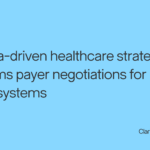Clarify Health’s CEO, Jean Drouin, MD, recently sat down with a panel of senior leaders from Horizon Blue Cross Blue Shield of New Jersey, Colorado Permanente Medical Group, and Mercer to discuss how the most innovative payers, providers, and employers are putting physician performance analytics into practice. The panelists were Divya Paliwal, MD, MHA, Chief Clinical Transformation Officer, Horizon BCBSNJ, Greg Berman, MD, Chief Acceleration Officer, Colorado Permanente Medical Group, and Jeff Dobro, MD, formerly Health & Benefits Strategy & Clinical Services Leader, Mercer. While they each play different roles in healthcare, they all have the same goal: to drive more value for their consumers (i.e., the patients). Dr. Dobro summed it up: “Improving healthcare starts by knowing whether we are doing a good job or not. The missing piece has been data and analytics. We have had a hard time defining what a good job even means,” he said. “How much more of the GDP can healthcare possibly take? Could it be one hundred percent—that’s all we do from now on is take care of sick people?” Dr. Berman of Colorado Permanente Medical Group said, “No one knew what anything cost. Then, we shared the data,” speaking about an initiative he’s driving to give physicians a data-driven view into their cost of surgery. “An exercise in transparency,” he called it. Dr. Berman’s mission is to arm physicians with data to make value-based decisions on behalf of their patients. When he showed the findings to his surgeons, here are a few examples of the changes they made. Surgeons saw, for the first time, that they were choosing an inferior non-clinical supply product because they assumed it would be less expensive, but as it turned out, the higher-quality product was the cheaper option. “Win-win, use the nicer product, and it’s actually less expensive,” commented Dr. Berman. He went on to say that surgeons were dismayed at some of the costs they saw. For example, when they saw the drastic difference in the cost of an embedded steroid versus injected steroid used for sinus surgery, the surgeons said, ‘take that off your shelf; we’re happy to inject the steroid as we go along.’ In the orthopedic space, they had six clavicle plates on contract, with varied prices from $400 per plate to $2,400. “So, with a curious mindset, we asked the question, why would we ever want the $2,400 plate?” The surgeon’s answer was appropriate: 10% of the time, they are needed for clavicle fractures. With that level of visibility, “we can track that,” said Dr. Berman. Even more exciting, he added, is giving patients visibility into their cost of surgery before they show up in our operating room. “If you need surgery on a broken ankle, we can give you the expected cost in a narrow range,” he said. Dr. Paliwal of Horizon BCBSNJ also shared an example. In January 2019, Horizon, a single state health plan based out of New Jersey, launched downside risk arrangements with one of their key OMNIA partners (covering over 30,000 members). The health plan quickly jumped in to help, providing data and analytics on their members’ clinical conditions and risk factors. Using those insights, they were able to mobilize care coordination teams to address the needs of their highest opportunity members. The advanced monthly payments (i.e., care coordination fees) helped them with these members. They also explored analytics to find other ways to help these members and found that co-investing in a pharmacist resource was critical. “In the very first year, we saw a 5% reduction in total cost of care compared to target, as well as improvement on quality metrics,” said Dr. Paliwal. But this kind of partnership does not happen overnight. Her sentiment was, this is a long game, requiring longstanding relationships, transparency, trust, and data-driven insights to help ground all parties in a common language. Dr. Paliwal shared a second example. Horizon found that another risk arrangement partner had very low prior authorization denial rates over a long period of time. Given the level of maturity of the provider, they felt it was appropriate to remove the standard prioritization requirements and let data analytics guide them instead. For example, now they can identify a radiologist who is a low-performer and work with them to become a high performer, rather than imposing a standard requirement on all radiologists. With the right analytics, “We are reimaging what the future medical management looks like,” said Dr. Paliwal. “Do we need to continue to do prior authorization the same way that we are doing it today? The answer is likely no.” Dr. Dobro, formerly of Mercer, talked about employers. For a long time, employers have relied on health plans and partners to bring value into the equation. Employers are using analytics, like Clarify’s and others, to take matters into their own hands. “Employers, especially self-insured employers, recognize that this is their money, and they want to purchase based on value, not just lowest cost, most access, or whatever happens to be available,” said Dr. Dobro. What the employers are saying now is, ‘hey, we have analytics and tools to look at any network option and do our own evaluation about whether we think it is a high quality, lower-cost option, or just a low-cost option.’ They are also asking the question: ‘In my market, who is doing a better job?’ Some employers are putting in place preferential benefit designs to use the providers that they have identified as high value. In 2021, there are a few employers pursuing this strategy. Dr. Dobro shared that there’s a lot of energy to pursue these kinds of preferred and direct contracts in the future. A resounding “yes,” from the panel. Dr. Dobro commented that while there is a perception of analytics-driven steerage, “What Colorado Permanente and Horizon are doing is different.” They’re using analytics to grow their understanding of their providers and build up the level of trust. Dr. Berman shared that at Colorado Permanente, they did a lot of communication and engagement with physicians before they ever collected a single bit of data. Once they had the data, they had very open and honest discussions about what it showed. If someone’s surgical costs were much more, it was a conversation about why and what can they do differently. “We wanted to make sure that they understood that affordability is a core part of our mission at Kaiser Permanente and that they play a huge role in that,” said Dr. Berman. “If that $2,400 plate is the only thing that’s right for a certain subset of patients, and we can predictably expect utilization, that’s now having an impact on our contracting strategy. Our surgeons are super excited about being a part of influencing the contracting piece,” he said. Dr. Drouin asked Dr. Paliwal, “do providers feel that physician performance analytics are another way for health plans to keep tabs on them?” She responded: “It’s quite the opposite. They say, ‘give us more.’” Analytics are increasingly important to drive alignment. A decade or so ago, performing favorably on value-based arrangements was relatively straightforward. Today, the levers are not that straightforward—it requires transforming care, improving the outcomes of the community, and preventing a patient from landing in an inpatient bed in the first place. That’s where analytics play an important role. She concluded that the power of insights is that they are driving engagement, a common understanding, and improving alignment. This topic is central to what we do at Clarify Health. We are an enterprise analytics platform company that turns healthcare data into the most actionable insights for health plans, providers, and life sciences. With Clarify’s precise case-mix adjusted insights our customers are reducing medical cost, optimizing provider networks, and driving value-based transformation.Can physician performance analytics really improve the value of care?
Do physicians act any differently when they see performance data?
Clarify Health powers smarter network design and management for payers
- Author Details





